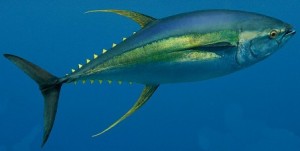Many month ago I came up with an idea. Â Seafood is one of the toughest areas for most servers to learn. Â Growing up in the Midwest most of the seafood I ate was called “fish” and usually served in “stick” form. Â Early in my restaurant career I served tilapia and cheap salmon. Â It wasn’t until I began working in a seafood restaurant that I really started to learn about fish. Â There is an incredible amount to learn.
I found numerous resources, both online and in print, to help me gain a better understanding of seafood and how to sell it. Â The problem is that each of these resources gave me one part of the picture. Â Seafood Watch is an incredible site, but it primarily designed to talk about the environmental impacts of different types of seafood. Â Fishbase has every detail you could imagine, but is designed for biologists rather than the average person. Â National Geographic has information, but it makes me feel guilty about eating the fish I read about.
So today I am going to try something different. Â I am going to give you the basics on two fish you might not know a lot about, but pop up on menus from time to time. Â This is a combination of information guests could ask about, trivial facts to create banter, and the scientific names that will allow you to research them more if you wish. Â This first installment covers Ahi Tuna and Mako Sharks. Â Check out the hyperlinks within the descriptions to find previous posts that I wrote in anticipation of launching this feature.
Yellowfin Tuna
Common Name(s): Ahi Tuna
Scientific Name: Thunnus albacares
Max Size: 441 lbs (200 Kg)
Common Size: 55 lbs (25 Kg)
Wild or Farmed: Wild caught and fed to weight
Schooling: Yes
Fishing Methods: Troll, Longline, Purse Seine
Mercury Level: High for longline only
Raw color: reddish pink
Cooked color: off white
Texture: Dense and chewy when raw to rare. Very firm and meaty when cooked past medium.
Trivial Facts
The Yellowfin Tuna received the name “ahi†from the Hawaian word for “fireâ€. This is due to the fact that they feed near the surface of the water near dusk. They reflection of the sun off their fins looks reminiscent of fire.
Yellowfin Tuna will often school with dolphins. This leads to a large amount of by-catch or dolphins. Modern fishing practices have reduced this problem significantly.
This is also often sold as “saku†when it has been previously smoked/glazed and is sold in cryovac packages.
Mako Shark
Common Name(s): Mackerel Shark, Dog Shark
Scientific Name: Isurus oxyrinchus
Max Size: 1750 lbs (759 Kg)
Common Size: 130-880 lbs (60-400 Kg)
Wild or Farmed: Wild
Schooling: No
Fishing Methods: Troll, Longline
Mercury Level: High
Raw color: Off white with hints of grey, pink, and red.
Cooked color: off white
Texture: Firm and meaty. No flake.
Trivial Facts
The Mako Shark is the fastest of all sharks. Scientist estimate they can reach speeds of over 60 mph and jump up to 30 feet in the air.
These sharks are aggressive and have been known to attack boats and swimmers without provocation.
The Mako Shark is closely related to the Great White Shark.
Contrary to urban legend, sharks can develop cancer.
Mako sharks (unlike most sharks that expel waste through their skin) have bladders.
Chum in the movie “Finding Nemo†is a Mako Shark.
I hope this feature helps both foodies and servers better understand these fish. Â I am also interested in hearing about any other fish you would like to see featured in this way. Â Leave a comment and you might see your species in the next fish post.





trying to find you on facebook
You have to be pretty ignorant to support the exploitation of these animals. Any idea how much damage longline fishing causes? Do the oceans a favour and go fuck yourself.
I generally have a no profanity policy, but I will make an exception here. I don’t intend to endorse the “exploitation” of either species. I link to two different organizations that cover the environmental impact of longlining extensively. Additionally, I link three times in the post to a seperate article that I have written dealing in depth with the different fishing methods. In this post I specifically address the harms of longlining.
I don’t think that it is always an option to make thes judgements. As a server, I am not allowed to lecture my guests. I am not here to judge, but rather to inform. What people do with that information is up to them.